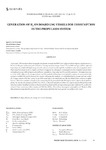Mostrar o rexistro simple do ítem
Generation of H₂ on Board Lng Vessels for Consumption in the Propulsion System
| dc.contributor.author | Arias-Fernández, Ignacio | |
| dc.contributor.author | Romero Gómez, Manuel | |
| dc.contributor.author | Romero Gómez, Javier | |
| dc.contributor.author | López-González, Luis M. | |
| dc.date.accessioned | 2020-07-03T10:41:25Z | |
| dc.date.available | 2020-07-03T10:41:25Z | |
| dc.date.issued | 2020 | |
| dc.identifier.issn | 1233-2585 | |
| dc.identifier.uri | http://hdl.handle.net/2183/25905 | |
| dc.description.abstract | [Abstract] At present, LNG vessels without reliquefaction plants consume the BOG (boil-off gas) in their engines and the excess is burned in the gas combustion unit without recovering any of its energy content. Excess BOG energy could be captured to produce H₂, a fuel with high energy density and zero emissions, through the installation of a reforming plant. Such H₂ production would, in turn, require on-board storage for its subsequent consumption in the propulsion plant when navigating in areas with stringent anti-pollution regulations, thus reducing CO₂ and SOₓ emissions. This paper presents a review of the different H₂ storage systems and the methods of burning it in propulsion engines, to demonstrate the energetic viability thereof on board LNG vessels. Following the analysis, it is identified that a pressurised and cooled H₂ storage system is the best suited to an LNG vessel due to its simplicity and the fact that it does not pose a safety hazard. There are a number of methods for consuming the H₂ generated in the DF engines that comprise the propulsión plant, but the use of a mixture of 70% CH₄-30% H₂ is the most suitable as it does not require any modifications to the injection system. Installation of an on-board reforming plant and H₂ storage system generates sufficient H₂ to allow for almost 3 days’ autonomy with a mixture of 70%CH₄-30%H₂. This reduces the engine consumption of CH₄ by 11.38%,thus demonstrating that the system is not only energy-efficient, but lends greater versatility to the vessel. | es_ES |
| dc.language.iso | eng | es_ES |
| dc.publisher | Sciendo | es_ES |
| dc.relation.uri | https://doi.org/10.2478/pomr-2020-0009 | |
| dc.rights | Atribución-NoComercial-SinDerivadas 4.0 | |
| dc.rights.uri | http://creativecommons.org/licenses/by-nc-nd/4.0/ | |
| dc.subject | Boil-off gas | es_ES |
| dc.subject | Efficiency | es_ES |
| dc.subject | H2 storage | es_ES |
| dc.subject | LNG vessel | es_ES |
| dc.subject | Reforming | es_ES |
| dc.title | Generation of H₂ on Board Lng Vessels for Consumption in the Propulsion System | es_ES |
| dc.type | info:eu-repo/semantics/article | es_ES |
| dc.rights.access | info:eu-repo/semantics/openAccess | es_ES |
| UDC.journalTitle | Polish maritime research | es_ES |
| UDC.volume | 27 | es_ES |
| UDC.issue | 1 | es_ES |
| UDC.startPage | 83 | es_ES |
| UDC.endPage | 95 | es_ES |
| dc.identifier.doi | 10.2478/pomr-2020-0009 |






